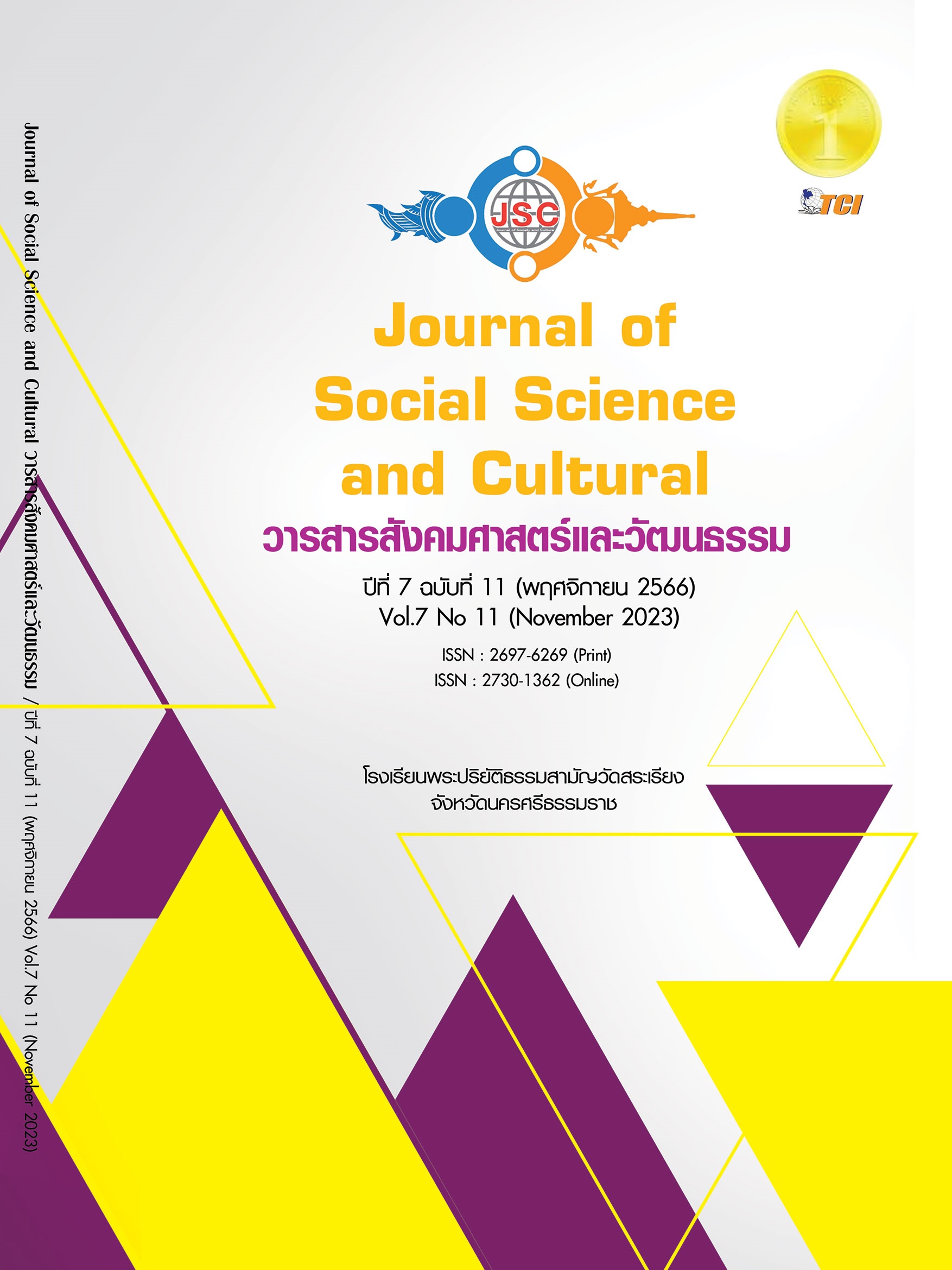IDENTITY DESIGN FOR COMMERCIAL SPACE OF COMMUNITY'S PRODUCTS AND MODIFICATION GUIDELINES FOLLOWING AREA SIZE
Main Article Content
Abstract
The research is a mixed-methods research both quantitative and qualitative. The objectives of the research are: 1) to study and analyze cultural identity characteristics that will be used in the community product display area 2) to design a prototype area based on the concept of creating an identity for the community product display area and adjusting the format according to the characteristics of the area and 3) to create knowledge in allocating space for community exhibitions which has special characteristics that can be adjusted in size. The research sample area chosen for this study is Phra Nakhon Si Ayutthaya Province. The research findings reveal that, study of cultural identity, community product exhibition area. The researcher has designated Phra Nakhon Si Ayutthaya Province as a sample area. Perform systematic analysis and synthesis. The highest average score evaluation result = 5.00 was History and Archaeology. Architecture of religious places, temples and craftsmen's fields is the basketry of carp Used to create 4 categories of identity: identity shape Identity pattern Identity color and Identity material. These identities help create clear recognition and can better communicate your identity in the exhibition space. Including product grouping Displaying products that helps promote a good image. The researcher has designed and created 4 prototype display areas, scaling up to a double-sized space that can be arranged and connected as needed. The design has taken into account the beauty of the environment within the space. Able to express identity appropriately Make it memorable Create more confidence in the product Exhibition space design Therefore, it is an important area used as a center for communicating identity to consumers, linking to design that is an important factor in spatial creativity. To distribute products that reflect identity and enhance the image of the community.
Article Details
References
กรมส่งเสริมวัฒนธรรม. (2559). วัฒนธรรม วิถีชีวิตและภูมิปัญญา. กรุงเทพมหานคร: บริษัท รุ่งศิลป์การพิมพ์ จำกัด.
กาญจนา แก้วเทพ. (2541). การวิเคราะห์สื่อ : แนวคิดและเทคนิค. กรุงเทพมหานคร: อินฟินิตี้เพรส.
ชัยรัตน์ อัศวางกูร. (2548). ออกแบบให้โดนใจ. กรุงเทพมหานคร: ฮั่วซินการพิมพ์.
นงค์นุช เจริญพร. (22 เมษายน 2564). การออกแบบอัตลักษณ์พื้นที่แสดงสินค้าผลิตภัณฑ์ชุมชนและแนวทางการปรับรูปแบบตามขนาดพื้นที่. (อภิชาติ ทวีวัฒน์, ผู้สัมภาษณ์)
นัดดาวดี บุญญะเดโช. (2562). การออกแบบภาพลักษณ์อุทัยธานีโมเดล เมืองแห่งสุนทรียวัฒนธรรม. ใน ดุษฎีนิพนธ์ปรัชญาดุษฎีบัณฑิต สาขาวิชาทัศนศิลป์และการออกแบบ. มหาวิทยาลัยบูรพา.
ปิติ มณีเนตร. (2555). การศึกษาสัญญะทางศิลปะและงานออกแบบตกแต่งภายใน พระรามราชนิเวศน์ จังหวัดเพรชบุรี เพื่อสร้างมูลค่าเพิ่มให้กับอุตสาหกรรมการท่องเที่ยวในประเทศไทย. ใน รายงานการวิจัย. มหาวิทยาลัยราชภัฏสวนสุนันทา.
ระยอง แก้วสิทธิ์. (22 เมษายน 2564). การออกแบบอัตลักษณ์พื้นที่แสดงสินค้าผลิตภัณฑ์ชุมชนและแนวทางการปรับรูปแบบตามขนาดพื้นที่. (อภิชาติ ทวีวัฒน์, ผู้สัมภาษณ์)
วิมลสิทธิ์ หรยางกูร. (2541). พฤติกรรมมนุษย์กับสภาพแวดล้อม : มูลฐานทางพฤติกรรมเพื่อการออกแบบและวางแผน. กรุงเทพมหานคร: สำนักพิมพ์จุฬาลงกรณ์มหาวิทยาลัย.
วิศิษฏ์ เพียรการค้า. (9 เมษายน 2564). การออกแบบอัตลักษณ์พื้นที่แสดงสินค้าผลิตภัณฑ์ชุมชนและแนวทางการปรับรูปแบบตามขนาดพื้นที่. (อภิชาติ ทวีวัฒน์, ผู้สัมภาษณ์)
สมภพ จงจิตต์โพธา. (2554). องค์ประกอบศิลป์. กรุงเทพมหานคร: โรงพิมพ์มิตรสัมพันธ์กราฟฟิค.
สันติ เล็กสุขุม. (2555). ศิลปะอยุธยา : งานช่างหลวงแห่งแผ่นดิน. กรุงเทพมหานคร: สำนักพิมพ์เมืองโบราณ.
สำนักงานจังหวัดพระนครศรีอยุธยา. (2566). บรรยายสุรุป จังหวัดพระนครศรีอยุธยา ปี 2565. เรียกใช้เมื่อ 9 ตุลาคม 2566 จาก https://ww2.ayutthaya.go.th/ebook/detail/29/data.html
Kobayashi, S. (1998). Colorist. Japan: Kodansha International Ltd.


